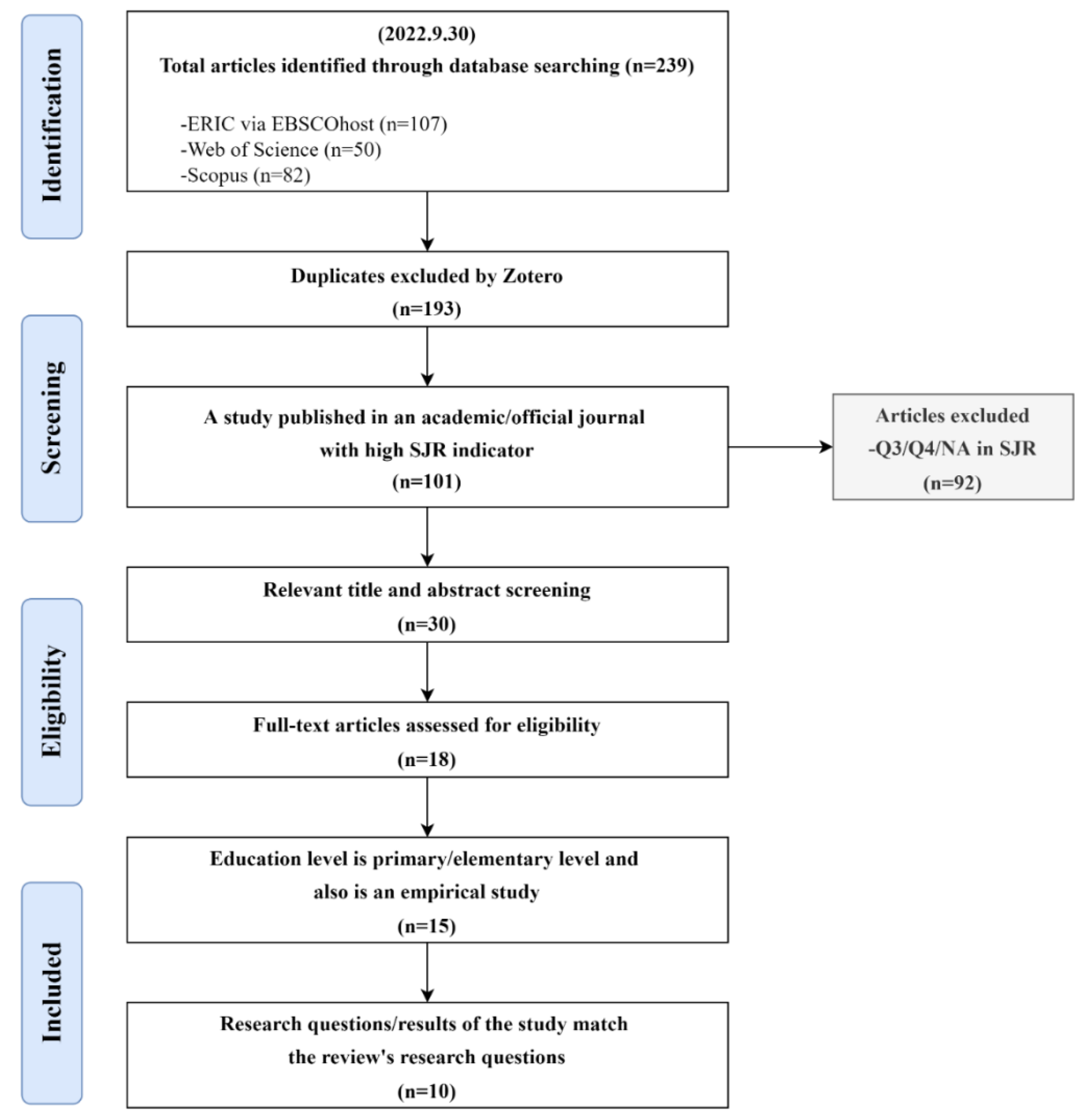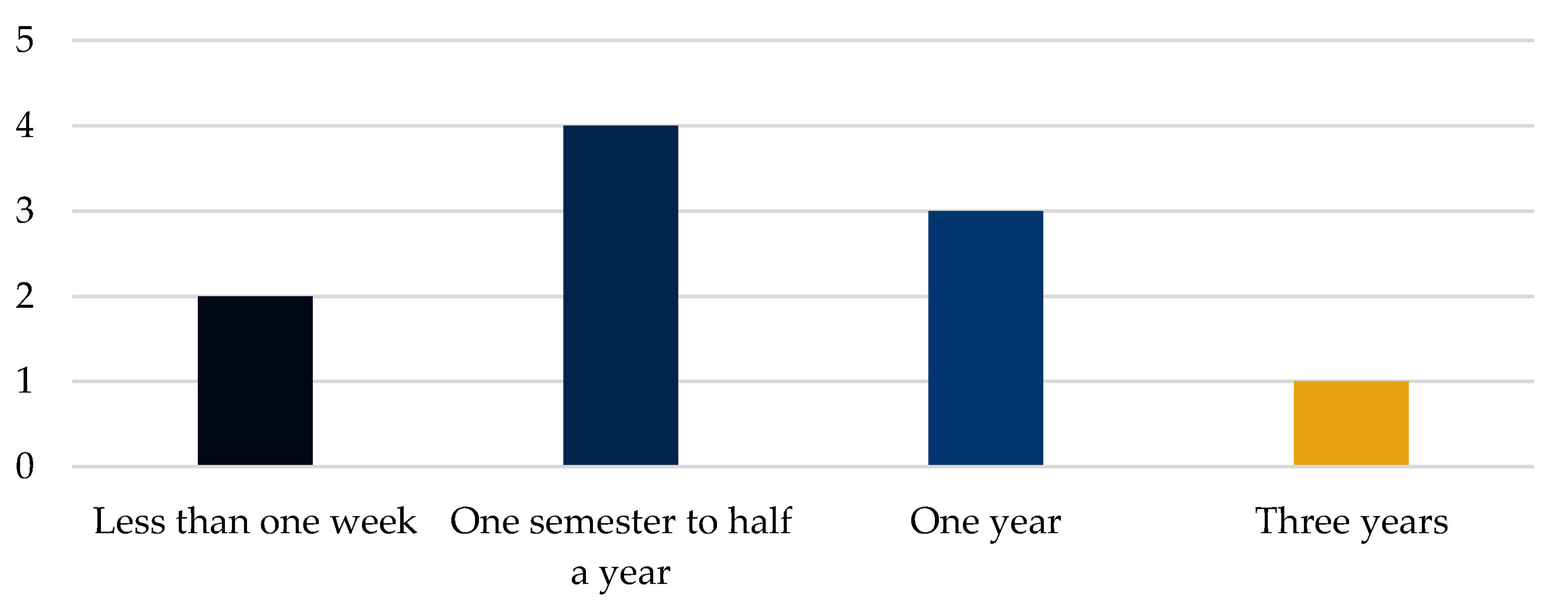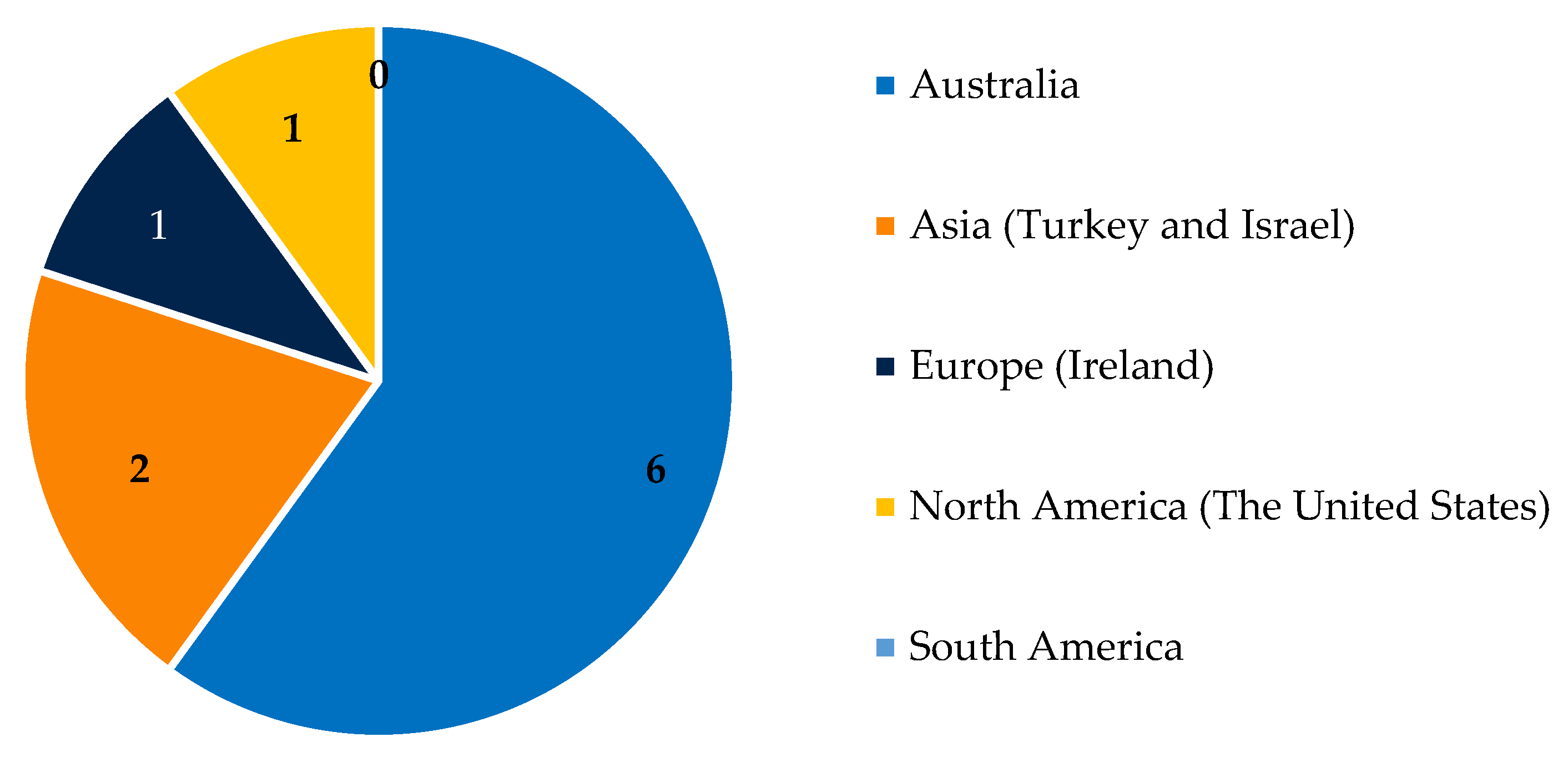Can Mathematical Modelling Be Taught and Learned in Primary Mathematics Classrooms: A Systematic Review of Empirical Studies
Abstract
:1. Introduction
- (1)
- What methods/strategies of professional development interventions are used to enhance primary teachers’ mathematical modelling competencies, and what are the effects?
- (2)
- What are the effects of mathematical modelling on primary students, and how can their mathematical modelling skills be improved?
- (3)
- How can the modelling skills of primary school teachers and students be assessed?
2. Literature Review
2.1. Mathematical Modelling Competency
2.2. Mathematical Modelling Activities
2.2.1. Data Modelling
2.2.2. Modelling with Cultural and Community Contexts
3. Search Strategies and Data Analysis Methodology
3.1. Search Strategies
3.2. Data Analysis
4. Results
4.1. Statistical Analysis: Participants, Methodology, Experimental Period, and Background
4.2. RQ1: What Methods/Strategies of Professional Development Interventions Are Used to Enhance Primary Teachers’ Mathematical Modelling Competencies, and What Are Their Effects?
4.3. RQ2: What Are the Effects of Mathematical Modelling on Primary Students, and Can Their Mathematical Modelling Skills Be Improved?
4.4. RQ3: How Can the Modelling Skills of Primary School Teachers and Students Be Assessed?
5. Discussion
6. Conclusions
Funding
Institutional Review Board Statement
Informed Consent Statement
Data Availability Statement
Conflicts of Interest
Appendix A
| Study (Author, Year) | Participants (Country) | Study Period | Methodology | Data | Results |
|---|---|---|---|---|---|
| Baker & Galanti (2017) | 8 mathematics coaches from each of the 8 division schools. (United States) | A 4-day summer institute on STEM integration and one coaching meeting a month for one year | Qualitative analysis: In-depth interviews Focus groups | Participant reflections (written documents, recording); Conversations | 8 participants expressed a willingness to use MEAs as a tool for STEM integration in their future curriculum design in grades K-6. |
| English (2006) | A class of 5th graders and their teachers. (Australia) | A three-year, longitudinal teaching experiment | Qualitative analysis: Case study In-depth interviews Focus groups | Videotapes and audiotapes; Responses to the problem activity; Worksheets and final reports; The class presentations; The children’s written critiques; Field notes of classroom observations | Elementary school students of all achievement levels contribute and benefit from mathematical modeling. Children will build their own mathematical ideas, hone their communication and teamwork abilities. |
| English (2010) | Three classes of first-grade children (25 to 26 students each class) and their teachers. (Australia) | The first year of a three-year, longitudinal teaching experiment; Regular half-day teacher meetings | Teaching experiment involving multilevel collaboration; Case study; In-depth interviews; Focus groups | Videotapes and audiotapes; The artefacts of all student groups; Whole-class presentations and discussions | Children’s abilities to focus their attention on the qualities of items and create a broad range of models in organizing, structuring, and representing their data. Children’s development of meta-representational knowledge. |
| English (2012) | Three classes of first-grade children (25 to 26 students each class) and their teachers. (Australia) | The first year of a three-year, longitudinal teaching experiment; Regular half-day professional development meetings | Teaching experiment involving multilevel collaboration; Qualitative analysis: Case study In-depth interviews Focus groups | Videotapes, audiotapes, and digital photographs; The artefacts of all student groups; Whole-class discussions and group presentations | Results included the various ways in which children represented and re-represented collected data, and the meta-representational competence they displayed in doing so. The children who dealt with informal inference were also reported. |
| English & Watson (2018) | A total of 89 students from 6th grade: 45 girls and 44 boys. (Australia) | At the end of a three-year (last half-year) longitudinal study | Intervention experiments; Design-based research; Content analysis; Statistical analysis; Case study; Focus groups | Documented in the students’ workbooks; Students’ annotations on the table of data; Transcripts of all whole class discussions and presentations | Modeling with data could develop primary school students’ statistical literacy. This modeling framework comprises four components. Currently, research received limited attention in the primary grades about modeling and inferential reasoning processes. |
| English & Watters (2005) | All four 3rd-grade classes and their teachers. The principal and assistant principal attended some debriefing meetings with the teachers. (Australia) | Activities were organized weekly for a semester. More than 4 to five 40-min lessons for each problem. The teachers had several workshops on introduction, the pre- and post-meetings. | Data analysis; Ethnomethodological; Case study; In-depth interviews; Focus groups | Videotapes and audiotapes; Classroom field notes; Children’s artifacts (including their written and oral reports); Children’s responses to their peers’ feedback in the oral reports. | The modeling problems encouraged young children to develop important mathematical ideas, the metacognitive and critical thinking skills. The study has also highlighted the contributions of these modeling activities to young children’s development of mathematical description, explanation, justification, and argumentation. |
| Hodgson & Wilkie (2021) | 18 in-service teachers from four primary schools (Australia) | A 5-month intervention program. Four stages of intervention (2 hours each). Another 60-min co-teaching planning meeting was appointed. | Multiple case studies; Interpretive accounts-of-practice methodological approach; In-depth interviews; Intervention experiment | Questionnaires; Audio recordings; Written documents; Research journal. | This study impelled teachers to reflect on and set goals for improving their practice. Suggestions for pre- and post-lesson protocols for productive discussions are proposed, and designing school-based professional learning processes using modeling. |
| Leavy & Hourigan (2018) | 24 participants from 2nd and 3rd grade, 2 teacher educators, and 25 pre-service teachers (Ireland) | A 4-day data modeling investigation including 4 60-min lessons. | Three-tiered teaching experiment; In-depth interviews | Digital dialog; Video recording; PST’s notes, observations, and transcripts of the group conversation. | This study extended previous research as it examines young children’s modelling potential. The extension of the study over a longer duration will reap interesting findings. |
| Shahbari & Peled (2015) | Two sixth-grade classes, 65 students from 6th grade in a primary school (Israel) | Three lessons | Qualitative analysis: Case study In-depth interviews Focus groups | Students’ worksheets, notes, and final models; Videotapes of student groups’ discussion. | Results showed that students utilized their knowledge of fractions in constructing mathematical models. Students had some difficulties in their knowledge of fractions. |
| Yasa & Karatas (2018) | 24 preservice elementary math teachers studying their second year in the university (Turkey) | In the spring semester of one academic year. The duration of the lessons was 3 lesson hours each week. | Mixed method: Single group pretest-posttest design; Intervention experiments; | A pre-mathematical modelling test; A post-mathematical modelling test | The result showed that the instruction based on mathematical modelling improved pre-service teachers’ mathematical modelling performance. |
References
- Li, Y.; Wang, K.; Xiao, Y.; Froyd, J.E. Research and Trends in STEM Education: A Systematic Review of Journal Publications. Int. J. STEM Educ. 2020, 7, 11. [Google Scholar] [CrossRef] [Green Version]
- Widya; Rifandi, R.; Rahmi, Y.L. STEM Education to Fulfil the 21st Century Demand: A Literature Review. J. Phys. Conf. Ser. 2019, 1317, 012208. [Google Scholar] [CrossRef] [Green Version]
- Just, J.; Siller, H.-S. The Role of Mathematics in STEM Secondary Classrooms: A Systematic Literature Review. Educ. Sci. 2022, 12, 629. [Google Scholar] [CrossRef]
- Mustafa, N.; Ismail, Z.; Tasir, Z.; Mohamad Said, M.N.H.B. A Meta-Analysis on Effective Strategies for Integrated STEM Education. Adv. Sci. Lett. 2016, 22, 4225–4288. [Google Scholar] [CrossRef] [Green Version]
- Ng, S.B. Exploring STEM Competences for the 21st Century; no.30; February 2019. Available online: https://pdfs.semanticscholar.org/55f1/bff79642ca16d1054ef78f16cbb2b1b83234.pdf (accessed on 15 October 2022).
- Hallström, J.; Schönborn, K.J. Models and Modelling for Authentic STEM Education: Reinforcing the Argument. Int. J. STEM Educ. 2019, 6, 22. [Google Scholar] [CrossRef] [Green Version]
- Gilbert, J.K.; Boulter, C.J.; Elmer, R. Positioning Models in Science Education and in Design and Technology Education. In Developing Models in Science Education; Gilbert, J.K., Boulter, C.J., Eds.; Springer: Dordrecht, The Netherlands, 2000; pp. 3–17. [Google Scholar] [CrossRef]
- Tezer, M. The Role of Mathematical Modeling in STEM Integration and Education. In Theorizing STEM Education in the 21st Century; IntechOpen: Rijeka, Croatia, 2019; pp. 1–14. [Google Scholar] [CrossRef] [Green Version]
- Kertil, M.; Gürel, C. Mathematical Modeling: A Bridge to STEM Education. Int. J. Educ. Math. Sci. Technol. 2016, 4, 44–55. [Google Scholar] [CrossRef]
- Lesh, R.; Doerr, H.M. Foundations of a Models and Modeling Perspective on Mathematics Teaching, Learning, and Problem Solving. In Beyond Constructivism: Models and Modeling Perspectives on Mathematics Problem Solving, Learning, and Teaching; Routledge: London, UK, 2003; pp. 3–33. [Google Scholar]
- Berry, J.; Houston, K. Mathematical Modelling; Gulf Professional Publishing: Woburn, MA, USA, 1995. [Google Scholar]
- Emery, N.S. Technological Literacy Programs in Elementary School. Available online: https://digitalcommons.odu.edu/cgi/viewcontent.cgi?article=1423&context=ots_masters_projects (accessed on 2 October 2022).
- Llinares, S.; Roig, A.I. Secondary School Students’ Construction and Use of Mathematical Models in Solving Word Problems. Int. J. Sci. Math. Educ. 2008, 6, 505–532. [Google Scholar] [CrossRef]
- Arikan, S.; Erktin, E.; Pesen, M. Development and Validation of a STEM Competencies Assessment Framework. Int. J. Sci. Math. Educ. 2022, 20, 1–24. [Google Scholar] [CrossRef]
- English, L.D.; Watters, J.J. Mathematical Modelling With 9-Year-Olds. In Proceedings of the 29th Annual Conference of the International Group for the Psychology of Mathematics Education, Melbourne, Australia, 10–15 July 2005; Chick, H., Vincent, J., Eds.; University of Melbourne: Melbourne, Australia, 2005; pp. 297–304. [Google Scholar]
- Lehrer, R.; Schauble, L. Modeling Natural Variation Through Distribution. Am. Educ. Res. J. 2004, 41, 635–679. [Google Scholar] [CrossRef]
- Diezmann, C.; Watters, J.; English, L. Teacher Behaviours That Influence Young Children’s Reasoning. In Proceedings of the 26th Annual Conference of the International Group for the Psychology of Mathematics Education, Norwich, UK, 21–26 July 2002; Nardi, E., Cockburn, A., Eds.; University of East Anglia: Norwich, UK, 2002; Volume 2, pp. 289–296. [Google Scholar]
- Lehrer, R.; Lesh, R. Mathematical Learning. In Handbook of Psychology: Educational Psychology; John Wiley & Sons Inc.: Hoboken, NJ, USA, 2003; Volume 7, pp. 357–391. [Google Scholar]
- English, L.D.; Watters, J.J. Mathematical Modelling in the Early School Years. Math. Educ. Res. J. 2005, 16, 58–79. [Google Scholar] [CrossRef] [Green Version]
- Blomhoej, M.; Højgaard, T. Developing Mathematical Modelling Competence: Conceptual Clarification and Educational Planning. Teach. Math. Its Appl. 2003, 22, 123–139. [Google Scholar] [CrossRef] [Green Version]
- Maaß, K. What Are Modeling Competencies? ZDM 2006, 38, 113–142. [Google Scholar] [CrossRef]
- National Governors Association Center for Best Practices & Council of Chief State School Officers. Common Core State Standards Mathematics; National Governors Association Center for Best Practices & Council of Chief State School Officer: Washington, DC, USA, 2010; Available online: http://www.corestandards.org/wp-content/uploads/Math_Standards1.pdf (accessed on 15 October 2022).
- English, L.D. Mathematical Modeling in the Primary School: Children’s Construction of a Consumer Guide. Educ. Stud. Math. 2006, 63, 303–323. [Google Scholar] [CrossRef]
- English, L.D. Mathematical and Interdisciplinary Modeling in Optimizing Young Children’s Learning. In Exploring Mathematical Modeling with Young Learners; Suh, J.M., Wickstrom, M.H., English, L.D., Eds.; Early Mathematics Learning and Development; Springer International Publishing: Cham, Switzerland, 2021; pp. 3–23. [Google Scholar] [CrossRef]
- Makar, K. Developing Young Children’s Emergent Inferential Practices in Statistics. Math. Think. Learn. 2016, 18, 1–24. [Google Scholar] [CrossRef]
- Wickstrom, M.H.; Yates, A. Mathematical Modeling: Analyzing Elementary Students’ Perceptions of What It Means to Know and Do Mathematics. In Exploring Mathematical Modeling with Young Learners; Suh, J.M., Wickstrom, M.H., English, L.D., Eds.; Early Mathematics Learning and Development; Springer International Publishing: Cham, Switzerland, 2021; pp. 209–233. [Google Scholar] [CrossRef]
- Bown, M.J.; Sutton, A.J. Quality Control in Systematic Reviews and Meta-Analyses. Eur. J. Vasc. Endovasc. Surg. 2010, 40, 669–677. [Google Scholar] [CrossRef] [PubMed] [Green Version]
- Shea, B.J.; Reeves, B.C.; Wells, G.; Thuku, M.; Hamel, C.; Moran, J.; Moher, D.; Tugwell, P.; Welch, V.; Kristjansson, E.; et al. AMSTAR 2: A Critical Appraisal Tool for Systematic Reviews That Include Randomised or Non-Randomised Studies of Healthcare Interventions, or Both. BMJ 2017, 358, j4008. [Google Scholar] [CrossRef]
- Research Guides: Education: Research Databases. Available online: https://guides.nyu.edu/education/databases (accessed on 18 October 2022).
- Tawfik, G.M.; Dila, K.A.S.; Mohamed, M.Y.F.; Tam, D.N.H.; Kien, N.D.; Ahmed, A.M.; Huy, N.T. A Step by Step Guide for Conducting a Systematic Review and Meta-Analysis with Simulation Data. Trop. Med. Health 2019, 47, 46. [Google Scholar] [CrossRef]
- Baker, C.; Galanti, T. Integrating STEM in Elementary Classrooms Using Model-Eliciting Activities: Responsive Professional Development for Mathematics Coaches and Teachers. Int. J. STEM Educ. 2017, 4, 10. [Google Scholar] [CrossRef] [Green Version]
- Hodgson, L.; Wilkie, K. Modelling Lessons for More than Imitation: Investigating Teachers’ Reactions and Decompositions of Unfamiliar Practices. J. Math. Teach. Educ. 2022, 25, 749–775. [Google Scholar] [CrossRef]
- Yasa, G.K.; Karatas, I. Effects of the Instruction with Mathematical Modeling on Pre-Service Mathematics Teachers’ Mathematical Modeling Performance. Aust. J. Teach. Educ. 2018, 43, 1–14. [Google Scholar] [CrossRef]
- English, L.D. Young Children’s Early Modelling with Data. Math. Educ. Res. J. 2010, 22, 24–47. [Google Scholar] [CrossRef]
- English, L.D. Data Modelling with First-Grade Students. Educ. Stud. Math. 2012, 81, 15–30. [Google Scholar] [CrossRef] [Green Version]
- English, L.D.; Watson, J. Modelling with Authentic Data in Sixth Grade. ZDM: Int. J. Math. Educ. 2018, 50, 103–115. [Google Scholar] [CrossRef] [Green Version]
- Leavy, A.; Hourigan, M. The Role of Perceptual Similarity, Context, and Situation When Selecting Attributes: Considerations Made by 5–6-Year-Olds in Data Modeling Environments. Educ. Stud. Math. 2018, 97, 163–183. [Google Scholar] [CrossRef]
- Shahbari, J.A.; Peled, I. Modelling in Primary School: Constructing Conceptual Models and Making Sense of Fractions. Int. J. Sci. Math. Educ. 2017, 15, 371–391. [Google Scholar] [CrossRef]
- Seto, C.; Magdalene, T.M. Mathematical Modelling for Singapore Primary Classrooms: From a Teacher’s Lens. In Mathematics Education: Expanding Horizons, Proceedings of the 35th Annual Conference of the Mathematics Education Research Group of Australasia, Singapore, 2–6 July 2012; Dindyal, J., Cheng, L.P., Ng, S.F., Eds.; MERGA: Singapore, 2012; pp. 672–679. [Google Scholar]
- Anhalt, C.; Cortez, R. Developing Understanding of Mathematical Modeling in Secondary Teacher Preparation. J. Math. Teach. Educ. 2015, 19, 523–545. [Google Scholar] [CrossRef]
- Ministry of Education of the People’s Republic of China. Mathematics Curriculum Standards for Compulsory Education; Beijing Normal University Press: Beijing, China, 2022. Available online: http://www.moe.gov.cn/srcsite/A26/s8001/202204/W020220420582346895190.pdf (accessed on 15 October 2022).
- Turner, E.; Bennett, A.; Granillo, M.; Ponnuru, N.; Mcduffie, A.; Foote, M.; Aguirre, J.; McVicar, E. Authenticity of Elementary Teacher Designed and Implemented Mathematical Modeling Tasks. Math. Think. Learn. 2022, 1–24. [Google Scholar] [CrossRef]
- Turner, E.; McDuffie, A.; Bennett, A.; Aguirre, J.; Chen, M.; Foote, M.; Smith, J. Mathematical Modeling in the Elementary Grades: Developing and Testing an Assessment. Int. J. Sci. Math. Educ. 2022, 20, 1387–1409. [Google Scholar] [CrossRef]
- Fraivillig, J. Strategies for Advancing Children’s Mathematical Thinking. Teach. Child. Math. 2001, 7, 454–459. [Google Scholar] [CrossRef]
- Tan, L.S.; Ang, K.C. A School-Based Professional Development Programme for Teachers of Mathematical Modelling in Singapore. J. Math. Teach. Educ. 2016, 19, 399–432. [Google Scholar] [CrossRef]
- Munter, C. Developing Visions of High-Quality Mathematics Instruction. J. Res. Math. Educ. 2014, 45, 584–635. [Google Scholar] [CrossRef]
- Doerr, H.M.; English, L.D. A Modeling Perspective on Students’ Mathematical Reasoning About Data. J. Res. Math. Educ. 2003, 34, 110–136. [Google Scholar] [CrossRef]
- Anhalt, C.O.; Staats, S.; Cortez, R.; Civil, M. Mathematical Modeling and Culturally Relevant Pedagogy. In Cognition, Metacognition, and Culture in STEM Education: Learning, Teaching and Assessment; Dori, Y.J., Mevarech, Z.R., Baker, D.R., Eds.; Innovations in Science Education and Technology; Springer International Publishing: Cham, Switzerland, 2018; pp. 307–330. [Google Scholar] [CrossRef]
- Tang, K.-S.; Williams, P.J. STEM literacy or literacies? Examining the empirical basis of these constructs. Rev. Educ. 2019, 7, 675–697. [Google Scholar] [CrossRef]




| Database | Search Terms | Additional Limiters |
|---|---|---|
| ERIC | (TI(modeling) OR TI(model-eliciting) OR TI(modelling)) AND (TI(education) OR AB(education) OR SU(education)) AND (TI(primary) OR TI(elementary) OR AB(primary) OR AB(elementary) OR SU(primary) OR SU(elementary)) AND (TI(math*) OR AB(math*) OR SU(math*)) The asterisk (*) represents any group of characters, including no character. | Full Text Peer Reviewed Language: English Date Published: -20220931 Academic Journals |
| WOS | (TI = (“modeling”) OR TI = (“model-eliciting”) OR TI = (“modelling”)) AND (TI = (education) OR AB = (education) OR SU = (education)) AND (TI = (primary) OR TI = (elementary) OR AB = (primary) OR AB = (elementary) OR SU = (primary) OR SU = (elementary)) AND (TI = (math*) OR AB = (math*) OR SU = (math*)) The asterisk (*) represents any group of characters, including no character. | English Article |
| Scopus | (TITLE(“modeling”) OR TITLE(“model-eliciting”) OR TITLE(“modelling”)) AND (TITLE-ABS-KEY(education)) AND ((TITLE-ABS-KEY(primary)) OR (TITLE-ABS-KEY(elementary))) AND (TITLE-ABS-KEY(math*)) | English Publication stage: Final Journal article |
Publisher’s Note: MDPI stays neutral with regard to jurisdictional claims in published maps and institutional affiliations. |
© 2022 by the authors. Licensee MDPI, Basel, Switzerland. This article is an open access article distributed under the terms and conditions of the Creative Commons Attribution (CC BY) license (https://creativecommons.org/licenses/by/4.0/).
Share and Cite
Wei, Y.; Zhang, Q.; Guo, J. Can Mathematical Modelling Be Taught and Learned in Primary Mathematics Classrooms: A Systematic Review of Empirical Studies. Educ. Sci. 2022, 12, 923. https://doi.org/10.3390/educsci12120923
Wei Y, Zhang Q, Guo J. Can Mathematical Modelling Be Taught and Learned in Primary Mathematics Classrooms: A Systematic Review of Empirical Studies. Education Sciences. 2022; 12(12):923. https://doi.org/10.3390/educsci12120923
Chicago/Turabian StyleWei, Yicheng, Qiaoping Zhang, and Jing Guo. 2022. "Can Mathematical Modelling Be Taught and Learned in Primary Mathematics Classrooms: A Systematic Review of Empirical Studies" Education Sciences 12, no. 12: 923. https://doi.org/10.3390/educsci12120923





